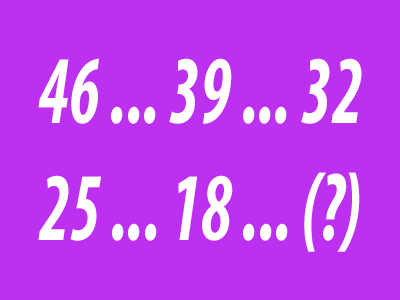
VR - Number Series Using Negative Arithmetic Progression
This is the last of our four articles on Number Series in the Eleven Plus Verbal Reasoning exam. There are several ways in which number series can be created. So far we have looked at Alternating Terms, Alternating Terms and Geometric Progression, and the much simpler Arithmetic Progression. In this final article, we look at number series which use negative arithmetic progression, and those which are made by adding consecutive numbers.
Number series formed by negative arithmetic progression are very simple. They are almost exactly the same as ones formed by regular arithmetic progression. The only difference is that, this time, we are subtracting numbers, rather than adding them. Ones made by adding consecutive numbers are trickier, but more on that later.
For the purpose of clarification, let’s show you some examples.Example Question One
Use the following series of numbers to determine what should come next.
| 50 | 42 | 34 | 26 | (?) |
To get from the first number to the second you must subtract eight. This carries through for each number so the answer will be 26 - 8 = 18.
There are all sorts of variations with this question but the majority of the time the first of its sort in a test paper will follow this straightforward style.
Technique Tip
Look out for the use of negative numbers - they may appear already in the sequence as the final number or the answer may be a negative number despite there having been none in the sequence. It's very common practise for the multiple-choice answers to include both the (correct) negative number and the same digit but without the ' - ' sign in front of it. This is a trick to catch out the unwary and often children misread and tick the wrong box.
I don't think we should be trying to punish those who are rushing through a tough exam and don't notice the tiny minus sign, but that's the way of things - warn your child in advance to check for things like that.
One final way that number series are created is by adding consecutive numbers:
Example Question Two
Use the following series of numbers to determine what should come next.
| 4 | 8 | 12 | 20 | 32 | (?) |
This is a tricky style of progression as it does not rely on a simple arithmetic or geometric progression. It is one of the hardest types for children to spot and there is often one of this kind at the end of a section. Ensure your child recognises it!
Technique Tip
The technique I teach for all of these questions is to write down the difference between each number and work from there. It may not provide the answer, but it will often help.
If we follow that then it will look something like this:
| 4 | (+4) | 8 | (+4) | 12 | (+8) | 20 | (+12) | 32 |
This technique allows a child to see if there is a clear progression but of course it doesn’t aid us greatly unless your son or daughter notices that there is a repeat of 4, 8, 12 in the differences between the numbers and the series itself.
Using this information, you should add 20 to the last number as 20 comes after 12 in the main series. That’s the awkward way of doing it but your child may like it. However, the simple way is to approach it with the knowledge of ways to create a series. Here, it’s the adding of consecutive numbers. 4 + 8 = 12, 8 + 12 = 20 and so on. The answer will be 20 + 32 = 52.
Sample Tests
So now we’ve learnt the various ways that numbers series are created and, more importantly, the best techniques for working them out. It’s time for your child to put what you have learnt into action. The more they practise, the less intimidating these sorts of question will be when they come across them in the exam.
There are four quizzes on the Education Quizzes site all about number series, which you may have played already. If not, have a go at them with your child now and, when necessary, give them some hints to help them find the correct answers.
You’ll find the quizzes in our Eleven Plus Verbal Reasoning section or, alternatively, you can follow these links:
That brings this section to an end. I do hope that you learned some useful ways to help your child in their exams. Good luck!




